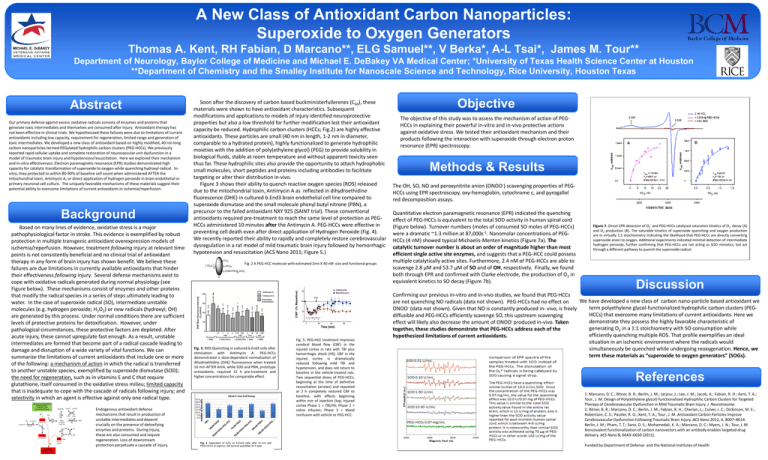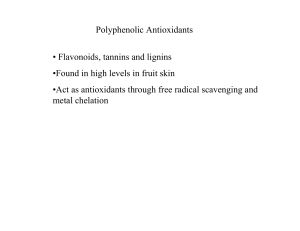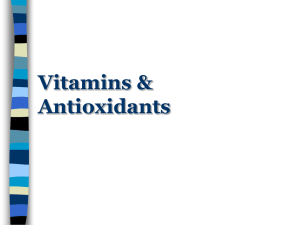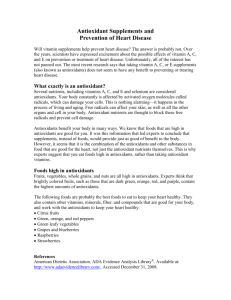A New Class of Antioxidant Carbon Nanoparticles
advertisement

A New Class of Antioxidant Carbon Nanoparticles: Superoxide to Oxygen Generators Thomas A. Kent, RH Fabian, D Marcano**, ELG Samuel**, V Berka*, A-L Tsai*, James M. Tour** Department of Neurology, Baylor College of Medicine and Michael E. DeBakey VA Medical Center; *University of Texas Health Science Center at Houston **Department of Chemistry and the Smalley Institute for Nanoscale Science and Technology, Rice University, Houston Texas Abstract Our primary defense against excess oxidative radicals consists of enzymes and proteins that generate toxic intermediates and themselves are consumed after injury. Antioxidant therapy has not been effective in clinical trials. We hypothesized these failures were due to limitations of current antioxidants including low capacity, requirement for regeneration, limited range and generation of toxic intermediates. We developed a new class of antioxidant based on highly modified, 40 nm long carbon nanoparticles termed PEGylated hydrophilic carbon clusters (PEG-HCCs). We previously reported rapid cellular uptake and complete restoration of neurovascular unit dysfunction in a model of traumatic brain injury and hypotension/resuscitation. Here we explored their mechanism and in-vitro effectiveness. Electron paramagnetic resonance (EPR) studies demonstrated high capacity for catalytic transformation of superoxide to oxygen while quenching hydroxyl radical. Invitro, they protected to within 80-90% of baseline cell count when administered AFTER the mitochondrial toxin, Antimycin A, or direct application of hydrogen peroxide in brain endothelial or primary neuronal cell culture. The uniquely favorable mechanisms of these materials suggest their potential ability to overcome limitations of current antioxidants in ischemia/reperfusion. Background Based on many lines of evidence, oxidative stress is a major pathophysiological factor in stroke. This evidence is exemplified by robust protection in multiple transgenic antioxidant overexpression models of ischemia/reperfusion. However, treatment following injury at relevant time points is not consistently beneficial and no clinical trial of antioxidant therapy in any form of brain injury has shown benefit. We believe these failures are due limitations in currently available antioxidants that hinder their effectiveness following injury. Several defense mechanisms exist to cope with oxidative radicals generated during normal physiology (see Figure below). These mechanisms consist of enzymes and other proteins that modify the radical species in a series of steps ultimately leading to water. In the case of superoxide radical (SO), intermediate unstable molecules (e.g. hydrogen peroxide; H2O2) or new radicals (hydroxyl; OH) are generated by this process. Under normal conditions there are sufficient levels of protective proteins for detoxification. However, under pathological circumstances, these protective factors are depleted. After acute injury, these cannot upregulate fast enough. As a result, unstable intermediates are formed that become part of a radical cascade leading to damage and disruption of a wide variety of vital functions. We can summarize the limitations of current antioxidants that include one or more of the following: a mechanism of action in which the radical is transferred to another unstable species, exemplified by superoxide dismutase (SOD); the need for regeneration, such as in vitamins E and C that require glutathione, itself consumed in the oxidative stress milieu; limited capacity that is inadequate to cope with the cascade of radicals following injury; and selectivity in which an agent is effective against only one radical type. Endogenous antioxidant defense mechanisms that result in production of unstable intermediates and depend crucially on the presence of detoxifying enzymes and proteins. During injury, these are also consumed and require regeneration. Loss of downstream protection perpetuate a cascade of injury. Soon after the discovery of carbon based buckministerfullerenes (C60), these materials were shown to have antioxidant characteristics. Subsequent modifications and applications to models of injury identified neuroprotective properties but also a low threshold for further modification lest their antioxidant capacity be reduced. Hydrophilic carbon clusters (HCCs; Fig.2) are highly effective antioxidants. These particles are small (40 nm in length, 1-2 nm in diameter, comparable to a hydrated protein), highly functionalized to generate hydrophilic moieties with the addition of poly(ethylene glycol) (PEG) to provide solubility in biological fluids, stable at room temperature and without apparent toxicity seen thus far. These hydrophilic sites also provide the opportunity to attach hydrophobic small molecules, short peptides and proteins including antibodies to facilitate targeting or alter their distribution in-vivo. Figure 3 shows their ability to quench reactive oxygen species (ROS) released due to the mitochondrial toxin, Antimycin A as reflected in dihydroethidine fluorescence (DHE) in cultured b.End3 brain endothelial cell line compared to superoxide dismutase and the small molecule phenyl butyl nitrone (PBN), a precursor to the failed antioxidant NXY 925 (SAINT trial). These conventional antioxidants required pre-treatment to reach the same level of protection as PEGHCCs administered 10 minutes after the Antimycin A. PEG-HCCs were effective in preventing cell death even after direct application of Hydrogen Peroxide (Fig. 4). We recently reported their ability to rapidly and completely restore cerebrovascular dysregulation in a rat model of mild traumatic brain injury followed by hemorrhagic hypotension and resuscitation (ACS Nano 2011; Figure 5.) O z HO2C OH m q Fig. 2 A PEG-HCC molecule with estimated 2nm X 40 nM size and functional groups CONH-PEG OCH3 n 1 Fig. 3. ROS Quenching in cultured b.End3 cells after stimluation with Antimycin A. PEG-HCCs demonstrated a dose-dependent normalization of dihydroethidine (DHE) fluorescence when treated 10 min AFTER AntA, while SOD and PBN, prototype antioxidants, required 12 h pre-treatment and higher concentrations for comparable effect. Fig. 4. Application of H2O2 on b.End3 cells; after 10 min add PEG-HCCs (2 mg/mL); cell survival quantified 24 h later. Fig. 5. PEG-HCC treatment improves cerebral blood flow (CBF) in the injured cortex in rats with TBI plus hemorrhagic shock (HS). CBF in the injured cortex is dramatically reduced following mild TBI and hypotension, and does not return to baseline in the vehicle-treated rats. Two sequential doses of PEG-HCCs, beginning at the time of definitive resuscitation (arrows) and repeated at 2 h completely restored CBF to baseline, with effects beginning within min of injection (top, injured cortex Phase 1 = TBI/HS; Phase 2 = saline infusion; Phase 3 = blood reinfusion with vehicle or PEG-HCC. Objective The objective of this study was to assess the mechanism of action of PEGHCCs in explaining their powerful in-vitro and in-vivo protective actions against oxidative stress. We tested their antioxidant mechanism and their products following the interaction with superoxide through electron proton resonance (EPR) spectroscopy. Methods & Results The OH, SO, NO and peroxynitrite anion (ONOO-) scavenging properties of PEGHCCs using EPR spectroscopy, oxy-hemoglobin, cytochrome c, and pyrogallol red decomposition assays. Quantitative electron paramagnetic resonance (EPR) indicated the quenching effect of PEG-HCCs is equivalent to the total SOD activity in human spinal cord (Figure below). Turnover numbers (moles of consumed SO moles of PEG-HCCs) were a dramatic ~1.3 million at 87,000s-1. Nanomolar concentrations of PEGHCCs (4 nM) showed typical Michaelis-Menten kinetics (Figure 7a). The catalytic turnover number is about an order of magnitude higher than most efficient single active site enzymes, and suggests that a PEG-HCC could possess multiple catalytically active sites. Furthermore, 2.4 nM of PEG-HCCs are able to scavenge 2.8 µM and 53.7 µM of SO and of OH, respectively. Finally, we found both through EPR and confirmed with Clarke electrode, the production of O2 in equivalent kinetics to SO decay (Figure 7b). Figure 7. Direct EPR detection of O2- and PEG-HCCs catalyzed saturation kinetics of O2- decay (A) and O2 production (B). The saturable kinetics of superoxide quenching and oxygen production are in virtually 1:1 stoichiometry indicating the likelihood that PEG-HCCs are directly converting superoxide anion to oxygen. Additional experiments indicated minimal detection of intermediate hydrogen peroxide, further confirming that PEG-HCCs are not acting as SOD mimetics, but act through a different pathway to quench the superoxide radical. Discussion Confirming our previous in-vitro and in-vivo studies, we found that PEG-HCCs We have developed a new class of carbon nano-particle based antioxidant we are not quenching NO radicals (data not shown). PEG-HCCs had no effect on term polyethylene glycol-functionalized hydrophilic carbon clusters (PEGONOO- (data not shown). Given that NO is constantly produced in- vivo, is freely HCCs) that overcome many limitations of current antioxidants. Here we diffusible and PEG-HCCs efficiently scavenge SO, this upstream scavenging demonstrate they possess the highly favorable characteristic of effect will likely also decrease the amount of ONOO- produced in-vivo. Taken generating O2 in a 1:1 stoichiometry with SO consumption while together, these studies demonstrate that PEG-HCCs address each of the efficiently quenching multiple ROS. That profile exemplifies an ideal hypothesized limitations of current antioxidants. situation in an ischemic environment where the radicals would simultaneously be quenched while undergoing reoxygenation. Hence, we term these materials as “superoxide to oxygen generators” (SOGs). References 1. Marcano, D. C.; Bitner, B. R.; Berlin, J. M.; Jarjour, J.; Lee, J. M.; Jacob, A.; Fabian, R. H.; Kent, T. A.; Tour , J. M. Design of Poly(ethylene glycol)-functionalized Hydrophilic Carbon Clusters for Targeted Therapy of Cerebrovascular Dysfunction in Mild Traumatic Brain Injury. J. Neurotrauma. 2. Bitner, B. R.; Marcano, D. C.; Berlin, J. M.; Fabian, R. H.; Cherian, L.; Culver, J. C.; Dickinson, M. E.; Robertson, C. S.; Pautler, R. G.; Kent, T. A.; Tour , J. M. Antioxidant Carbon Particles Improve Cerebrovascular Dysfunction Following Traumatic Brain Injury. ACS Nano 2012, 6, 8007–8014. Berlin, J. M.; Pham, T. T.; Sano, D. S.; Mohamedali, K. A.; Marcano, D. C.; Myers, J. N.; Tour, J. M. Noncovalent functionalization of carbon nanovectors with an antibody enables targeted drug delivery. ACS Nano 5, 6643–6650 (2011). Funded by Department of Defense and the National Institutes of Health




